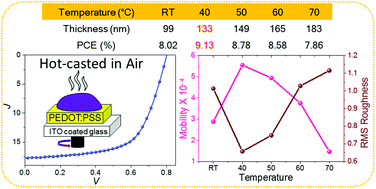Regulating active layer thickness and morphology for high performance hot-casted polymer solar cells†
Abstract
Thick films of active layers (Polymer: PCBM blend) are required to harness the maximum amount of sunlight and to achieve higher efficiencies in polymer solar cells. However, the realization of thick films along with desired morphology of the active layer is very challenging. Herein, thick films with optimum morphologies have been precisely obtained using the hot-casting technique. The superior active layer morphology supports better charge transport. The photovoltaic properties of the polymer solar cells fabricated with PTB7-Th:PC71BM were thoroughly studied by varying the substrate temperatures used for hot-casting. A significant increase in the power conversion efficiency to >9% was observed for the solar cells fabricated at 40 °C compared to those fabricated at room temperature, which displayed an efficiency of ∼8%. The main reason for this improvement was the increased thickness of the active layer that facilitated better light absorption and therefore resulted in the enhancement of the short circuit current density. In addition, the devices fabricated at 40 °C exhibited very low rms roughness enabling better charge transport in the device. The recombination studies and mobility estimation were also performed through the impedance spectroscopy and SCLC technique, which gave a clearer insight into the hot casting method. The outcome of this moderate hot-casting technique to achieve low roughness morphology in the thick active layer was very promising as this would be a possible breakthrough technique in the manufacturing of highly efficient polymer solar cells.



 Please wait while we load your content...
Please wait while we load your content...